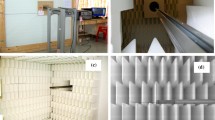Abstract
Reverberation chamber (RC), in which a complex electromagnetic environment is created, is of great interest as a versatile test and measurement tool, and its performance is conveniently evaluated through the field statistics. Following a previous paper in which the generalized extreme value (GEV) distribution was proposed to model the maximum field inside an RC, this work presents an experimental validation of the GEV use for the overmoded RC. The electric field is measured with a small sensor for a large number of points inside the RC, and the GEV parameters are accurately estimated. Since the maximum field distribution for this overmoded RC is found to be of reverse Weibull type, the field distribution is right bounded by a higher level that can be determined.











Similar content being viewed by others
Notes
In a statistical sense.
This small number of stirrer positions is compensated by the large number of probe locations (≈750 instead of 8 in [1]).
We have eliminated the measurements corrupted by transmissions errors occurring between the sensor and the computer, via optic fiber. The slight variations of NP are purely random.
The apparent variation of k with the frequency is assumed to be of random nature. The mean value k = 0.067 belongs to each of the three confidence intervals.
References
International Electrotechnical Commission, IEC 61000–4–21 (2003) Electromagnetic compatibility: reverberation chamber test methods. International Electrotechnical Commission (IEC), Genève
Hill DA (1994) Plane wave integral representation for fields in reverberation chambers. IEEE Trans Electromag Compat 36(3):169–178
Ladbury JM, Koepke GH, Camell DG (1999) Evaluation of the NASA Langley Research Center Mode-Stirred Chamber Facility. National institute of standards and technology 1508:288, Citation: NIST TN—1508
Kostas J, Boverie B (1991) Statistical model for a mode-stirred chamber. IEEE Trans Electromag Compat 33(4):366–370
Lehman TH, Freyer GJ (1997) Characterization of the maximum test level in a reverberation chamber. IEEE Int. Symposium on EMC, Austin, Texas USA, pp 44–47
Hoijer M (2006) Maximum power available to stress onto the critical component in the equipment under test when performing a radiated susceptibility test in the reverberation chamber. IEEE Trans Electromagn Compat 48(2):372–384
Orjubin G (2007) Maximum field inside a reverberation chamber modeled by the generalized extreme value distribution. IEEE Trans Electromag Compat 49(1):104–113
Orjubin G, Wong MF (2008) Use of the generalized extreme value distribution to model the maximums of the field inside a reverberation chamber. XXIX General Assembly, Chicago, USA
Gradoni G, Arnaut LR (2010) Generalized extreme value distributions of power near a boundary inside electromagnetic reverberation chambers. IEEE Trans Electromag Compat 52(3):506–515
Galambos J (1987) The asymptotic theory of extreme order statistics. Wiley, NewYork
Fisher RA, Tippett LHC (1928) Limiting forms of frequency distributions of the largest or smallest member of a sample. Proc Cambridge Philos Soc 24:180–190
Kotz S, Nadarajah S (2001) Extreme value distributions: theory and applications. World Scientific, New Jersey
Hill DA, Ladbury JM (2002) Spatial-correlation functions of fields and energy density in a reverberation chamber. IEEE Trans Electromag Compat 44(1):95–101
Orjubin G, Richalot E, Mengué S, Picon O (2006) Statistical model of an undermoded reverberation chamber. IEEE Trans on Electromag Compat 48(1):248–251
Lemoine C, Besnier P, Drissi M (2007) Investigation of reverberation chamber measurements through high-power goodness-of-fit tests. IEEE Trans Electromag Compat 49(4):745–755
Acknowledgments
The authors would like to acknowledge M. Thierry Sarrebourse for conducting the measurements.
We thank the reviewers for their many suggestions to improve this text.
Author information
Authors and Affiliations
Corresponding author
Additional information
Dr. Man-Fai Wong deceased.
Rights and permissions
About this article
Cite this article
Orjubin, G., Wong, MF. Experimental determination of the higher electric field level inside an overmoded reverberation chamber using the generalized extreme value distribution. Ann. Telecommun. 66, 457–464 (2011). https://doi.org/10.1007/s12243-011-0259-6
Received:
Accepted:
Published:
Issue Date:
DOI: https://doi.org/10.1007/s12243-011-0259-6




